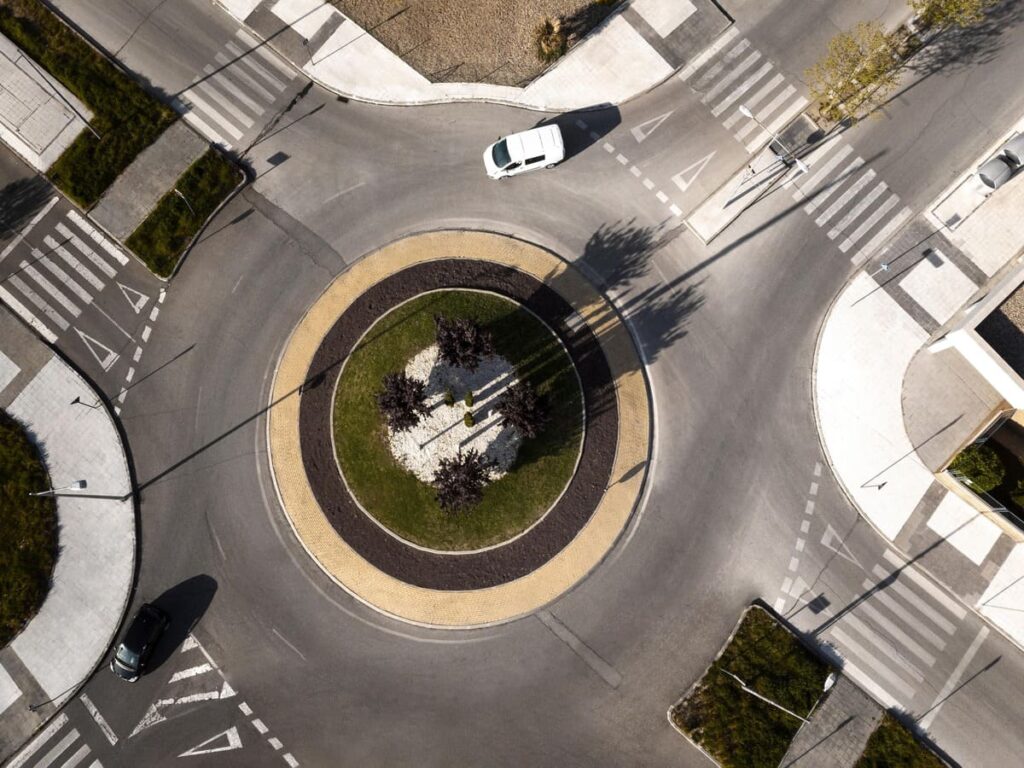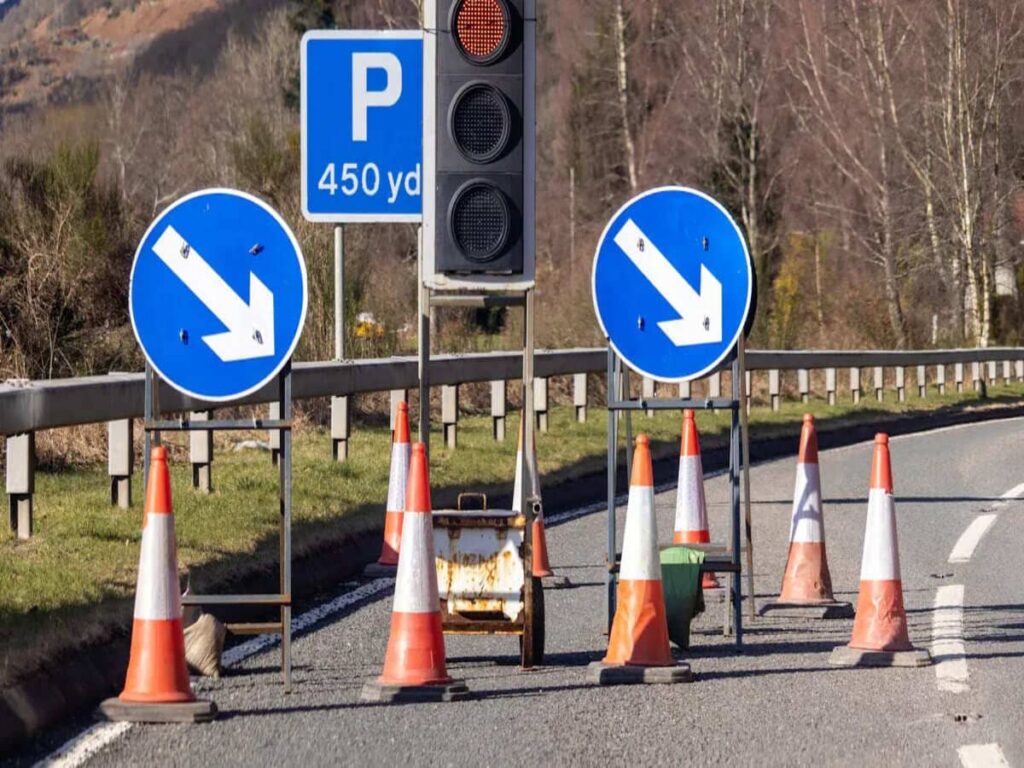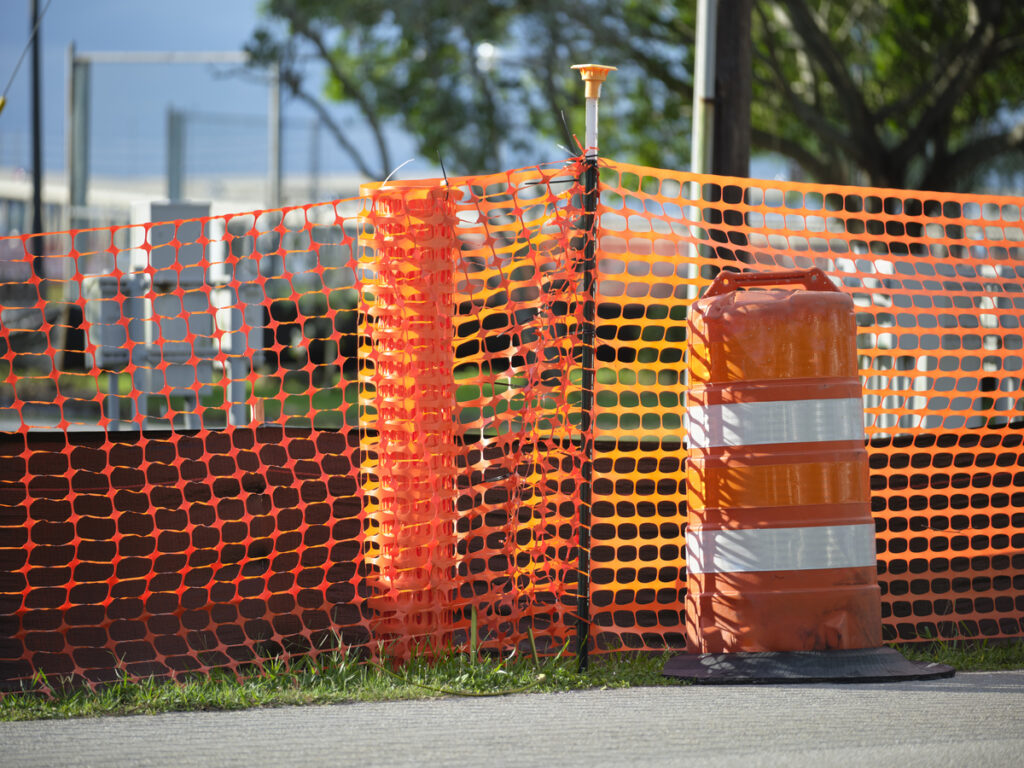
You need to secure an orange construction safety fence the right way. This helps your site stay safe and neat. The bright fence is a clear warning for people. It keeps people away from dangerous places. You see an orange construction safety fence at most job sites. It is easy to see and simple to put up. If you install a safety fence the right way, you protect workers and tools. A strong orange construction safety fence can handle bad weather. It helps your project stay on schedule.
To ensure your safety fence stands the test of time and harsh conditions, you need reliable, 高品質の製品. OPTRAFFIC offers durable and weather-resistant construction safety fences for sale, designed to keep your worksite secure. With easy installation and robust materials, our fences provide the peace of mind you need to focus on your project.
Why Secure an Orange Construction Fence
安全性とコンプライアンス
You want your construction site to be safe for everyone. An orange construction fence acts as a strong safety barrier fencing that keeps people out of dangerous areas. This fence is not just a suggestion—it helps you follow important rules. 米国で, local laws often require you to use temporary fencing to mark off work zones. Some places even have rules about the type of construction site fencing you must use. 例えば, you may need a fence that is at least four feet tall for homes or six feet for bigger projects.
知っていましたか? OSHA規格 say you must use temporary fencing to control who enters your site and to keep workers and the public safe. The orange construction fence stands out because of its high visibility feature. This bright color warns people to stay away from hazards.
ヨーロッパで, you also need to make sure your site is safe. Contractors must use temporary fencing solutions that protect workers and the public. You should always check local rules to make sure your safety fence solutions meet the law. Using a secure orange construction fence helps you avoid fines and keeps your project running smoothly.
- The fence must be stable and strong.
- It should be easy to see from far away.
- You need to check and fix the fence often to keep it working well.
Site Security
You do not want strangers or animals wandering onto your site. A well-secured orange construction fence helps you control who comes in and out. This keeps your tools, 装置, そして労働者の安全. The benefits of orange construction fences go beyond just safety. They also help you protect your project from theft or damage.
When you use temporary fencing, you create a clear line between your work area and the outside world. This makes it easier to manage your site. You can add locks or gates for extra security. A strong orange construction fence also stands up to wind and weather, so your site stays protected day and night.
ヒント: Always use the right fasteners and check your fence after storms. This keeps your safety barrier fencing strong and reliable.
By securing your orange construction fence, you show that you care about safety and site security. You also meet the rules for construction site fencing and help your project succeed.
Construction Safety Fence Materials
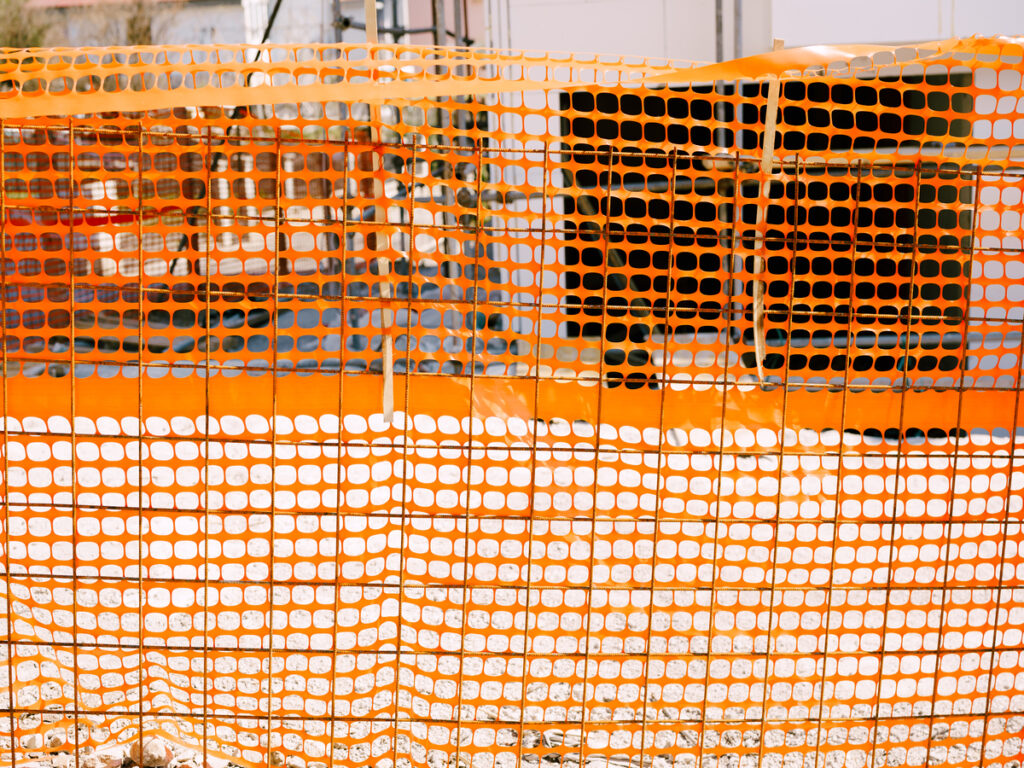
Fence Types and Materials
You want a fence that is strong and easy to see. Most orange fences are made from HDPE or ポリプロピレン (pp). These materials last a long time in bad weather. The orange color is bright so people notice it fast. You can pick mesh shapes like rectangles or diamonds. These shapes help people see the fence better. Check out this table to compare the features:
| 特徴 | 詳細 |
|---|---|
| 材料 | HDPE, ポリプロピレン (pp) |
| プロパティ | 軽量, UV stabilized, 耐久性, anti-corrosion, リサイクル可能 |
| 可視性 | 明るいオレンジ, various mesh designs, meets OSHA/ANSI standards |
| 耐久性 | 耐紫外線性, 続く 5 年, handles -60°F to 180°F |
| サイズ | Heights 3’–5′, lengths 100 ft–100 m, mesh 1″–3.75″ |
| インストール | 再利用可能, フレキシブル, easy to install and remove |
HDPE fences are a good choice for most job sites. They are safe for kids and pets. You can roll up the fence when you finish.
投稿, 賭け金, and Fasteners
You need the right posts and fasteners to keep your fence up. Metal posts like T-posts or U-posts are strong and last a long time. Plastic posts are lighter and good for quick jobs. Here is a table to show your choices:
| タイプ | 長所 | 短所 |
|---|---|---|
| Metal Posts | 強い, 安全な, 耐久性 | 重い, can rust, もっと費用がかかる |
| Plastic Posts | 軽量, 使いやすい | 耐久性が低い, may crack |
| Zip Ties | 速い, 単純, 安い | May break in cold weather |
| クランプ | Very secure, 再利用可能 | Need tools to install |
Use metal posts and strong fasteners if you want the fence to last. 短い仕事の場合, plastic posts and zip ties are fine.
Essential Tools and Safety Gear
Get your tools and safety gear before you start. You will need these things:
- Steel posts or wooden stakes
- Zip ties or clamps
- Hammer or post driver
- Tape measure
- 手袋, hard hat, 安全メガネ, steel-toe boots
- High-visibility vest
ヒント: Always wear your safety gear when you put up a construction safety fence. This keeps you safe and helps you follow the rules.
Planning and Layout
サイト評価
Before you start putting up your orange construction fence, you need to look at your site closely. Walk around and check for any hazards or special areas that need extra care. The orange construction fence works well because it is easy to see and lets air flow through, but you still need to plan where it goes.
Here are some things you should think about during your site assessment:
- Check local building codes and get any permits you need. This helps you follow the rules.
- Look at your property lines and make sure you do not cross into a neighbor’s yard or a utility area.
- Pay attention to the soil. Soft or rocky ground can make it hard for posts to stay up.
- 天気について考えてください. Windy spots may need stronger posts or extra support.
- Talk to a professional if you are not sure where to put the fence or what materials to use.
ヒント: The orange construction fence is great for construction sites, 公開イベント, and places where you need to control access. Its lightweight design makes it easy to move if your site layout changes.
Marking Boundaries
Once you finish your site assessment, you need to mark where the fence will go. This step helps you avoid mistakes and keeps your project on track.
Follow these steps to mark your boundaries:
- Walk the site with a team and note any trees, plants, or features you want to protect.
- Draw a simple map that shows property lines, ユーティリティ, and where you plan to build.
- Mark protection zones on your map. These are areas where you need to keep people out.
- Work with experts like arborists or builders to make sure your plan is solid.
- Use bright spray paint or flags to mark the fence line on the ground.
- Put up clear “keep out” signs along the marked line.
- Leave enough space around trees or special areas to keep them safe.
注記: Marking your boundaries before you install the fence saves time and helps you avoid problems later.
Installing Fence Posts
Post Placement and Spacing
You want your orange construction fence to stand strong and last through the whole project. The way you place your fence posts makes a big difference. Start by measuring the fence line with a tape measure. Mark each spot where you plan to put a post. Most experts suggest spacing your posts 6 に 8 足が離れています. This range gives your fence the best support and keeps it from leaning or falling over.
Spacing your posts correctly helps spread out the weight of the fence. You avoid weak spots and make sure the fence stays upright, 風の強い天気でも. If your soil is soft or sandy, you might need to place posts closer together. Rocky or hard-packed soil lets you stick to the 6 に 8 feet guideline.
Here’s a quick checklist for post placement:
- Measure and mark the fence line.
- Space posts 6 に 8 feet apart for stability.
- Adjust spacing for soil type and wind exposure.
- Make sure each post is straight and aligned.
ヒント: Use a string line to keep your posts in a straight row. This makes your orange construction fence look neat and professional.
Securing with Concrete or Stakes
After you set your post locations, you need to anchor them so your orange construction fence stays secure. You have two main choices: concrete or stakes. Each method works best in different situations.
コンクリート:
Concrete gives you strong, long-lasting support. It works well in rocky or hard-packed soils and areas with lots of wind. You dig a hole for each post, pour in the concrete, and let it cure. This takes more time and effort, but your posts will not move easily. Concrete also helps if you want a taller fence or need extra durability.
賭け金:
Stakes are quick and easy to install. You drive them into the ground with a hammer or post driver. Stakes work well in clay, sandy, or loamy soils. They save you time and money, especially for temporary jobs. Driven posts can be just as strong as concrete in most soils, except for loose sand. Stakes also avoid problems like frost heave, which can happen with concrete in cold climates.
Here’s a table to help you choose:
| 方法 | に最適です | 長所 | 短所 |
|---|---|---|---|
| コンクリート | Rocky/hard soil, 風 | とても強い, 耐久性 | Labor-intensive, needs curing |
| 賭け金 | Clay, sandy, loamy soil | 速い, easy, 費用対効果 | Less durable in tough weather |
注記: Think about your soil type, 天気, and how long you need the fence. Concrete works best for tough conditions and long-term use. Stakes are perfect for quick setups and softer ground.
When you secure your posts the right way, your orange construction fence will stand up to wind, 雨, and busy workdays. You keep your site safe and your project on track.
Attaching the Orange Construction Fence
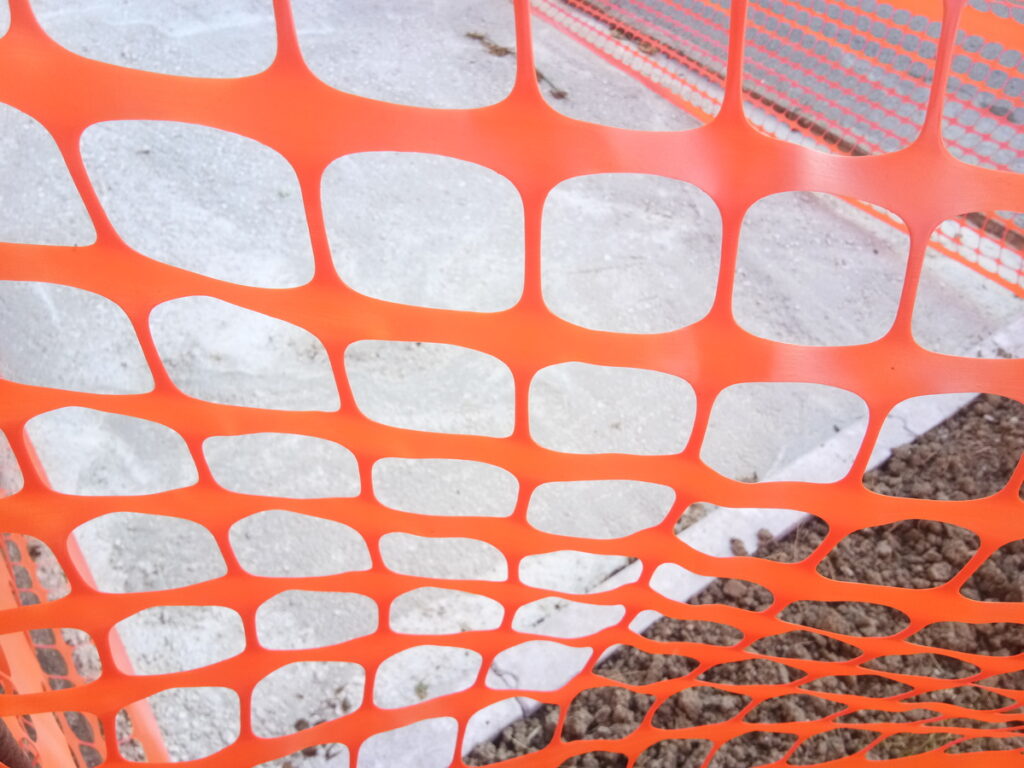
Stretching and Fastening
Now you have your posts in place, it’s time to attach the orange fence. This step makes sure your fence stays tight and does not sag. You want the fence to look neat and work well. Here’s how you can stretch and fasten your orange construction fence like a pro:
- Start at the First Post
Secure the end of the fence to your starting post. Make sure it is attached firmly. Only connect it to this post for now. - Inspect the Fence
Before you stretch, check the fence for any weak spots, さび, or brittle areas. Fix or replace any damaged parts so the fence does not break when you pull it tight. - Use a Fence Stretcher
Attach a safety fence come-along tool to an anchor point just past the next post. Hook the fence stretcher onto the fence. Use enough hooks to match the height of your fence. - Stretch the Fence
Crank the come-along tool. This pulls the orange construction fence tight. Keep going until the fence is straight and taut, but do not pull so hard that it tears. - Fasten to the Next Post
Once the fence is tight, fasten it to the new post. Use zip ties, fencing nails, or clamps for a secure hold.
ヒント: If you want your fence to last, always keep it tight. A loose fence can sag or blow over in strong wind.
Securing Top and Bottom Edges
You want your orange construction fence to stay put, even when the weather gets rough. Securing both the top and bottom edges is key. This step stops the fence from lifting or flapping.
- Fasten Along the Posts
Use zip ties, fencing nails, or clamps at every post. Make sure you use all the holes or teeth on the posts. This spreads out the pressure and keeps the fence from slipping. - Secure the Top Edge
Attach the top of the fence to each post. You can use zip ties, plastic cap staples, or corrosion-resistant fasteners. Stainless steel fasteners work best if your site gets a lot of rain. - Secure the Bottom Edge
Fasten the bottom edge to the posts or to ground stakes. This keeps animals and wind from getting under the fence.
Here’s a quick table to help you pick the right fastener:
| Fastener Type | 最適です |
|---|---|
| Zip Ties | 素早い, easy, good for temporary jobs |
| Fencing Nails | 強い, 安全な, best for long-term use |
| Stainless Steel Fasteners | 錆びない, great for wet environments |
| クランプ | Extra hold, 再利用可能, 道具が必要です |
注記: Pneumatic nailers and staplers make the job faster and help you get a tight fit. Always use corrosion-resistant fasteners for outdoor jobs.
Reinforcing Corners and Gates
Corners and gates are the weak spots in any construction safety fence. You need to give them extra support so your orange construction fence stays strong, even in high winds or busy areas.
- Add Diagonal Braces
Place diagonal braces on corner and gate posts. These braces can boost stability by up to 80%. They stop the posts from leaning or twisting. - Use Metal Corner Brackets
Metal brackets at the corners help hold everything together. They give extra strength where the fence needs it most. - Install Heavy-Duty Hinges and Drop Rods on Gates
Gates take more stress than the rest of the fence. Use heavy-duty hinges to stop sagging. Drop rods keep the gate locked to the ground, making it much harder for wind to move it. - Cross Bracing for Gates
Add a cross brace (diagonal support) to each gate. This keeps the gate from warping or drooping over time. - Deep Post Anchors
In soft or wet soil, use deep anchors for your posts. This stops the fence from shifting or falling over.
ヒント: If your site gets strong winds, use hurricane straps or extra horizontal supports. These upgrades help your orange construction fence stand up to storms.
When you take the time to reinforce corners and gates, your fence will last longer and keep your site safer. You can trust your orange construction fence to do its job, no matter what the weather brings.
Ensuring Stability and Safety
Tensioning the Fence
You want your orange construction fence to stay tight and upright. If the fence sags, it can look messy and may not keep people safe. Here’s how you can keep the tension just right:
- Secure the wire to each post using slip knots and insulators. This stops the wire from touching the ground and losing tension.
- Use gripple tools to adjust the tension easily. Aim for about 150 に 200 pounds of tension so the fence stays firm.
- Place solid corner posts at every sharp turn. These posts help hold the fence tight and prevent sagging.
- Set up the fence in sections. Connect each section at the corner posts with jumper cables. This keeps the fence strong and stable.
- Space your regular line posts 8 に 12 足が離れています. Drive them at least 2 feet deep for extra support.
- Check the tension often. Trim any plants or branches that touch the fence. This keeps the fence from getting loose over time.
ヒント: If you notice the fence getting loose, tighten it right away. A tight fence keeps your site safe and looks professional.
Weatherproofing and Support
Storms and strong winds can test your fence. You need to make sure your orange construction fence stands up to tough weather. Try these weatherproofing tricks:
- Install posts deep in the ground with concrete footings. Make the concrete at least 6 inches wider than the post. This helps the fence stay put in soft soil.
- Use galvanized or stainless steel fasteners. These fasteners don’t rust, even in wet or coastal areas.
- Apply waterproof sealants to wood posts and protective coatings to metal ones. This stops moisture from causing damage.
- Reinforce panel connections with locking washers or thread-locking compounds. These keep the fence from shaking loose in the wind.
- Add diagonal bracing at corners and gates. Wind-permeable fence designs, like shadowbox styles, 風の圧力を下げるのに役立ちます.
- For vinyl fences, use metal inserts at stress points and anchor them well. Composite materials also work great in stormy areas because they stay strong for years.
| Weatherproofing Method | 利点 |
|---|---|
| Deep concrete footings | Stops posts from shifting |
| Corrosion-resistant fasteners | Prevents rust and breakdown |
| 保護コーティング | Blocks moisture damage |
| Diagonal bracing | Adds strength in high winds |
注記: Regular checks and quick fixes help your construction safety fence last longer, even when the weather gets wild.
避けるべき一般的な間違い
Poor Post Installation
You want your orange construction fence to stand strong. If you rush the post installation, you might face problems later. Many people make mistakes like setting posts too shallow or using the wrong anchors. Posts that are not deep enough can lean or fall over. 時々, people use top mount anchors that rust or stick out after you remove the fence. This makes it hard to put the posts back in the same spot next time.
Here’s a quick look at common post installation mistakes and how you can avoid them:
| よくある間違い | 説明 | 避ける方法 / 解決 |
|---|---|---|
| Damaged Barriers and Stud Anchors | Frequent attachment and wear can damage anchors, making the fence unstable. | Use drop-in anchors to protect concrete and keep your safety barrier fencing secure. |
| Offsetting Future Installations | Old anchors rust or stick out, forcing you to move posts. | Use a Side Saddle Bracket™ so you can always mount posts in the same place. |
| Creating Footholds for Climbing | Poor design lets people climb the fence. | Choose barrier systems that remove footholds and boost site safety. |
ヒント: Always check your anchors and use the right hardware for your soil and site. This keeps your fence safe and easy to reinstall.
Improper Fasteners
Fasteners hold your construction safety fence together. If you pick the wrong ones, your fence can come loose or even fall. Zip ties are quick, but they can snap in cold weather. Some people use plastic ties for long jobs, but these may not last. Metal clamps or stainless steel fasteners work better for tough sites.
これが覚えておくべきことです:
- 強い使用, weatherproof fasteners for long-term projects.
- Check fasteners after storms or heavy use.
- Replace any broken or rusty parts right away.
注記: Good fasteners keep your fence tight and your site safe.
Loose or Sagging Fence
A loose or sagging fence does not look good. It also cannot keep people out. If you do not stretch the fence tight or secure the top and bottom, it will sag. This makes it easy for wind to blow the fence over or for people to sneak under.
これを避けるため:
- Stretch the fence tight when you install it.
- Secure both the top and bottom edges at every post.
- Add extra support at corners and gates.
If you see your fence sagging, すぐに修正します. A tight fence keeps your site safe and shows you care about your work.
メンテナンスと検査
定期点検
You want your orange construction fence to stay strong and safe. 定期的なチェックは、問題を早期に発見するのに役立ちます. Walk along the fence every week. Look for loose posts, sagging sections, or missing fasteners. Check the gates and corners. Make sure nothing is leaning or broken. Tighten any loose hardware right away. If you see the fence sagging, re-stretch it so it stays tight.
ヒント: Keep a checklist on your phone or clipboard. This helps you remember what to look for each time.
Adjustments and Repairs
時々, your orange construction fence needs a quick fix. You can handle most repairs with basic tools. Here’s a handy table to guide you:
| Common Fence Issue | What To Do | Tools You Need |
|---|---|---|
| Loose hardware | Tighten nails, ネジ, またはブラケット | Screwdriver, ドリル, hammer |
| Rust on metal parts | Clean rust, add rust inhibitor | Wire brush, rust remover |
| Damaged wood sections | Fill or replace wood | Wood filler, new wood |
| Fading/weathered wood | Seal or stain | Waterproof sealant or stain |
| Misaligned gates | Adjust hinges or add gate springs | Hand tools, gate springs |
Follow these steps for repairs:
- Inspect the fence for damage.
- Gather your tools.
- Tighten or replace loose parts.
- Fix or swap out broken posts or panels.
- Treat rust or weathered spots.
- Adjust gates so they open and close smoothly.
注記: Always wear gloves and safety glasses when you repair the construction safety fence.
Weather Considerations
Bad weather can test your fence. Wind and storms may push or bend it. You can add sandbags or weighted supports at the base. This keeps the orange construction fence from blowing over. In stormy seasons, check the fence more often. After heavy rain or wind, walk the fence line and fix any damage right away.
叫ぶ: Extra bracing at corners and gates helps your fence stand up to strong winds.
Routine care and quick repairs keep your orange construction fence working well all year.
Quick Installation Checklist
Ready to put up your orange construction fence? Use this checklist to make sure you do not miss a step. A good setup keeps your site safe and your fence strong.
Before You Start:
- Walk the fence line and clear away rocks, trash, and any leftover construction materials.
- Level the ground where you can. This helps your posts stand straight and your fence stay tight.
- Make sure you have enough space for installers to move and work easily.
- Plan where you want gates. Think about how people and equipment will get in and out.
Setting Up the Fence:
- Place T-posts or stakes every 6 に 8 feet along your marked line. This spacing gives your temporary fencing the best support.
- Unroll the orange fence and stretch it tight as you go. Secure it to each post with zip ties or wire.
- Overlap the ends of each fence roll by at least one foot. Tie off these overlaps so you do not have loose ends that could trip someone.
- Double-check that the fence is taut and not sagging anywhere. A tight fence works better and looks more professional.
- Make sure gates open and close without trouble. Use strong hinges and latches for extra security.
ヒント: If your fence will stay up for more than a day, walk the line and inspect it often. Look for loose ties, sagging spots, or anything out of place. Quick fixes keep your temporary fencing solutions working their best.
A simple checklist like this saves you time and helps you avoid common mistakes. You get a safer, クリーナー, and more secure job site every time.
Securing your orange construction fence helps keep your site safe. ルールを守ることにも役立ちます. It shows you care about doing a good job. You need strong posts for your fence. The fencing should stand up to bad weather. Use tough zip ties to hold it together. If you plan, インストール, ストレッチ, and check your fence, you can stop problems before they start.
Using bright, strong materials from good suppliers makes your work easier. It also helps keep your site safe.
Pick good products so you feel calm and know your construction safety fence will protect your site every time.
よくある質問
How tall should my orange construction fence be?
Most job sites use fences that stand 4 に 6 高さの足. You should check your local rules before you start. Taller fences work better for big projects or places with lots of foot traffic.
Can I reuse my orange construction fence?
はい, あなたはできる! If you take care of your fence and store it in a dry place, it will last for many projects. Just check for damage before you use it again.
What tools do I need to install the fence?
You need a hammer or post driver, zip ties or clamps, a tape measure, and safety gear like gloves and glasses.
ヒント: Gather all your tools before you start. これにより時間が節約されます.
How do I keep my fence from blowing over in strong wind?
Add sandbags or weighted supports at the base. Use extra bracing at corners and gates.
- Deep posts help, あまりにも.
- Check your fence after storms.
Do I need a permit to put up a temporary construction fence?
You might need a permit, depending on your city or county. Always check with your local building office before you start. This helps you avoid fines and keeps your project on track.


